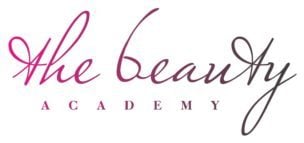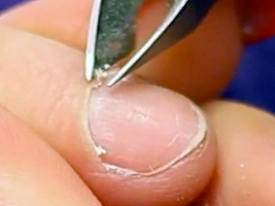How to Troubleshoot the Most Common Problems with Nail Extensions
Issues with nail extensions lifting or coming off prematurely as usually down to a number of specific reasons linked to incorrect application or improper home care by the client following application. We discuss the most common problems nail technicians will see and how to resolve here:
Nails are too thick when finished:
Ensure you apply UV Gel in thin coats, using no more than 3 layers of the UV Gel.
When applying Acrylic, ensure you follow the ‘3 Zone Application Technique’ to ensure you are correctly shaping the nails, with a correctly positioned apex (stress point) and avoid applying too big a bead of acrylic with each zone as this will leave the nails too thick as the acrylic dries.
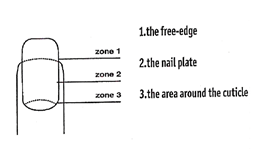
Client reports nails are lifting from base of the nail, by the cuticles:
This usually indicates that the prep stage of application was not thorough enough.
It may that eponychium was left on the nail plate, nails were not dehydrated with a bonder or dehydrator product before applying Gel or Acrylic product, or that moisture was trapped in the nails when the extensions were applied (do not soak nails before applying extensions).
Client reports nail extensions are ‘popping off’:
This can be caused by a number of things. Most commonly, the nail tip that has been selected and applied is too small which means the nail tip is flattened when glued to the nail and works against the natural curve of the nails. This means the tip can snap or come away when put under any kind of pressure.
It may also be due to air bubbles then the glue was applied to the tip, which does not give a secure bond.
Alternatively the UV Gel or Acrylic product may have been applied too thickly which limits the nails ability to flex under normal conditions and pressure.
Also check where you have made the ‘curvature’ or apex point and ensure it is correctly placed to allow the extension to endure reasonable pressure. As a guide, when you press on the free edge of each nail; the nail bed area that turns white indicates where your apex should be positioned (thickest part of your product).
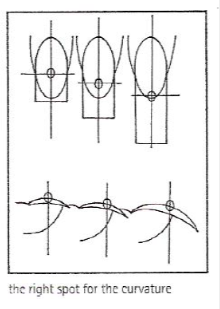
Nails are just not lasting for one specific client:
Review their consultation – check they do not have any conditions which affect hormones like pregnancy or menopause, that they are not taking anti-depressants, that they do not spend prolonged periods in hot water such as washing up or long baths, that they don’t use calcium-removing or glass cleaning products at work (e.g. hospital or catering work).
Harsh treatment of nails such as those who engage in racket sports, gardening, outdoor pursuits etc. Those who are nail biters. Using nails as tools and not jewels.
Lifestyle, medical factors and improper following of homecare advice are the most common reasons for poor longevity of nails and lifting of extensions. If it is just particular clients having issues, this suggests one of these reasons are to blame. Review their consultation, issue home care in writing and reduce the time between treatments so they are having more regular maintenance to keep nails healthy.
If numerous clients are having similar issues, try to identify a pattern with the products used and check your techniques, especially the preparation stage is correct.
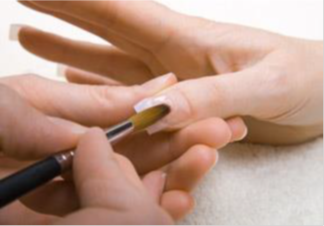
Client regularly experiences lifting of several nails within days of their period:
Some clients are very sensitive to hormonal changes and these changes can cause an increase in sebum production in the skin and nails, which can cause lifting to nail extensions.
Such clients are advised to have more regular maintenance perhaps timed around their menstrual cycle.
It is also common in pregnancy and menopause to find nails may lift due to having softer or more oily nail plates. Using a bonder / primer during the application stage can help with retention but can dry out nails over time so daily use of cuticle oil is recommended for these clients. Also they will require shorter maintenance intervals i.e., no longer than 2-3 weeks between treatments.
Alternatively suggest overlay treatments on natural nails (no false tip) or gel polish to encourage healthy natural nail growth, rather than nail extensions to help them achieve stronger nails with results lasting longer.
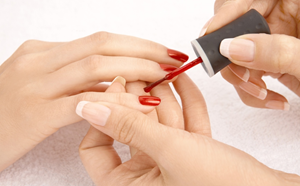
The client has entirely lost or broken a nail extension such as index finger and injured the natural nail underneath:
This is usually caused by an extreme knock or damage to the nails.
Ask the client if they are using the nails as ‘tools and not jewels’, using the nails to open things such as ring pulls on cans can cause too much pressure on the nail extension and cause breakage or lifting from the cuticle area with the tell-tale lifted natural nail plate layers from the apex area down to free edge. This is a clear sign the breakage was down to force on the nail.
Advise the client to use the end of a spoon to open ring pulls etc., and never use the nails to pick at anything such as labels.
Also on future treatments, suggest finishing nails to a shorter length for the client as this is most common when the nails are too long for the client’s lifestyle. Consider reducing time between maintenance appointments too to rebalance regrowth and reposition the apex as required sooner.
It can also be a sign that the client has very weak natural nails. Acrylic is a much harder adhering system than UV Gel generally speaking, which tends to have somewhat greater flexibility and a more gentle adhesion to the natural nail (usually resulting in less damage if the client does damage a nail).
Recommend the client have the extensions removed and natural nail services only such as nail overlay (no false tip) such as builder gel in a bottle or gel polish until the nails are healed. Do not work on any cut or bruised nails. Encourage the client to use cuticle oil daily to improve nail flexibility and skin/nail condition.
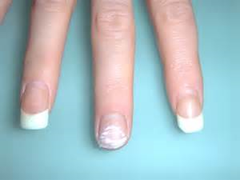
If the client has severely injured a nail extension and the natural nail:
If the client has fractured the extension (a split horizontally across the nail plate/extension), this may cause pain and/or unstabilise the extension risking further nail damage. It is usually caused by a severe knock or blow to the nails, such as trapping the nail in a door.
Ensure the client returns to you ASAP to assess the damage. Advise the client to keep the wounded clean, apply some colour-less iodine if an open wound and keep covered with a sterile dressing or micropore tape, but not a plaster as these can trap moisture and encourage bacterial infections to develop. If there are any signs of bleeding, swelling or infection, do not touch the enhancement until it is healed, otherwise you could end up causing further damage or even infection. If no signs of open wound or once wound has sufficiently healed, remove all traces of the nail extension and check the natural nail underneath for any further problems. Refer them to a medical professional if you are concerned.
A client regularly suffers breaks to the nails:
The most common reason for the breaking or tearing of artificial nails is that the customer hits the nail too hard or puts the nail under pressure to open something. In practice, clients often say they do not know how the nail was broken. The “nothing happened, I just saw the nail was gone”. In this situation, inspect how the nail is broken.
If the nail has broken at the apex with a snapped free edge, the nail will have impacted directly with some form of surface. If the nail has lifted off at the cuticle or apex then the nail was placed under excessive pressure. Fortunately these problems can be easily solved; first by filing and/or soaking away the remainder of the artificial nail, and then applying a new extension to the nail.
If this is a regular occurrence, check the health of the client’s nails. They may have soft or damaged nail plates that cannot hold a further extension and may need a ‘nail break’. Offer overlay (no tip) or gel polish services while nails recover. Alternatively for regular ‘nail breakers’, provide the client with their home care in writing and begin making an appointment charge for any nail repairs, rather than a ‘per nail’ charge which many nail techs offer. This will help deter those who fail to follow homecare.
How to handle nail breaks:
Some nail technicians will offer the first repair free of charge and just charge for any subsequent repairs ‘per nail’ (which should be a rare occurrence) until the next maintenance treatment.
Other nail technicians might charge per nail to be repaired but then offset this repair charge as a discount against their next maintenance treatment which ensures they continue to rebook with you for nail services.
If you have regular ‘nail breakers’ you might wish to charge a minimum appointment fee, rather than fee per nail to cover your time and cosAlternatively you may just bring the client’s regular maintenance appointment forward repairing any broken nails and rebalancing all other nails at the same time to ensure they nail extensions continue to grow out at the same rate. This avoids additional repair costs for your clients.
Provided you handle the customer experience positively by asking how they experienced the break or when they became aware of it, you can then tailor advice to help them protect against future nail breaks.
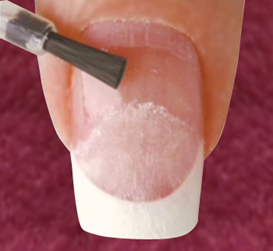
How often should maintenance be given:
Clients should ideally return to have the regrowth section infilled every 2-3 weeks. Some clients may be able to have a longer duration between maintenance treatments, however a greater level of maintenance will be required if clients return only every 4-6 weeks as you will need to also rebalance the stress point of the nails and infill the regrowth area. This costs you longer in time and product as a nail technician so you may wish to have two prices depending on whether an in-fill (2-3 weeks) or rebalance (3-6 weeks). Clients who do not have regular maintenance risk damage to the extensions and therefore potentially damage to their natural nails.
Clients must agree to commit to the maintenance involved with extensions and should be booked in for a maintenance appointment before the leave their first appointment to ensure this is adhered to. It is not recommended to continue to offer nail extension treatments to clients who cannot commit to the time or cost of regular appointments.
Those who simply want occasional or less frequent appointments may be recommended to natural nail treatments. Gel Polish will still grow out after 2-3 weeks however is unlikely to damage nails if left for longer durations than extensions and may be a suitable alternative provided it is removed correctly. You could consider retailing a home removal kit for Gel Polish for such clients.
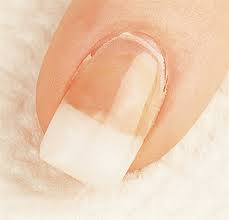
Looking to Qualify as an Accredited Nail Technician?
We offer both ABT Accredited Classroom Courses available on a fast track basis across our 10 training centres nationwide. Courses from Only £199!
Alternatively you can study conveniently from home and flexibly around other commitments with our IPHM Accredited Online Courses from Only £99!
First published 10th March 2016. Updated 3rd August 2023.
